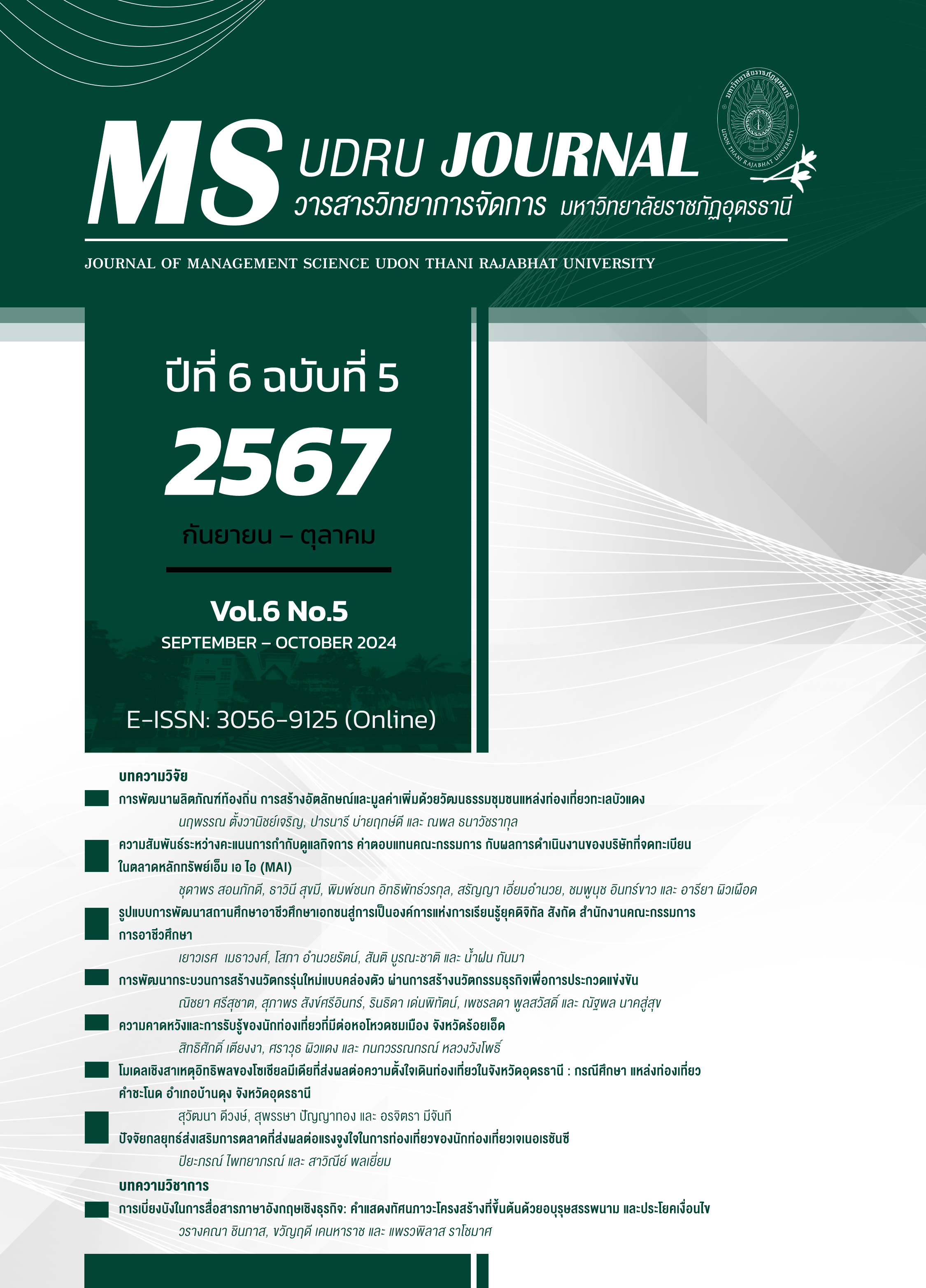HEDGING IN BUSINESS ENGLISH COMMUNICATION: MODALITY, IMPERSONAL IT CONSTRUCTIONS, AND CONDITIONAL SENTENCES
Main Article Content
Abstract
This study investigates the use of hedging or moderating the expressive tone of truth or directness in business English communication, focusing on three language tools: modality, impersonal constructions, and conditional sentences. The objective is to analyze and illustrate how these three devices hedge or control meanings conveyed in business communication. The study employed a comparative analysis and illustrative examples as discussion methods. The analysis draws upon five language sources, including textbooks, books, research, and online teaching materials, to provide spoken and written English expressions from authentic business contexts. The study also examines hedging devices that rely on syntactic and pragmatic aspects, specifically epistemic and deontic meanings. The findings show that the examples of English used in authentic business contacts discussed are from situations including letter correspondence, job-recruitment emails, notices, presentations, business trends, and an office operation. The three hedging devices illustrate two types of hedging strategies. First, they create politeness by reducing the assertive tone of directness while the speakers or writers master business negotiations, proposals, agreements, and requirements. Second, the devices help mitigate undesirable business results, including misunderstanding, risk, and future unpromising business commitment, by softening too-solid assumptions and limiting uncertainty. The findings support that incorporating the three hedges proposed into business English communication skill enhancement can equip learners with the devices for more effective interactions in professional settings.
Article Details

This work is licensed under a Creative Commons Attribution-NonCommercial-NoDerivatives 4.0 International License.
บทความที่ได้รับการตีพิมพ์เป็นลิขสิทธิ์ของคณะวิทยาการจัดการ มหาวิทยาลัยราชภัฏอุดรธานี
ข้อความที่ปรากฏในบทความแต่ละเรื่องในวารสารวิชาการเล่มนี้ ไม่ใช่ความคิดเห็นและความรับผิดชอบของผู้จัดทำ บรรณาธิการ กองบรรณาธิการ และคณะวิทยาการจัดการ มหาวิทยาลัยราชภัฏอุดรธานี ความรับผิดชอบด้านเนื้อหาและการตรวจร่างบทความแต่ละเรื่องเป็นความคิดเห็นของผู้เขียนบทความแต่ละท่าน
References
Biber, D., Conrad, S., & Leech, G. (2002). Longman Student Grammar of Spoken and Written English. Essex: Pearson Education Limited.
Brown, G., & Yule, G. (1983). Discourse Analysis. Cambridge: Cambridge University Press.
Brown, P., & Levinson, S. C. (1987). Politeness: Some Universals in Language Usage (14th ed). Cambridge: Cambridge University Press.
Business letter. (n.d.). Course Hero. https://www.coursehero.com/file/47721678/BUSINESS-LETTERdocx.
Cambridge University Press & Assessment. (2024). Hedging. Cambridge Free Dictionary and Thesaurus. https://dictionary.cambridge.org/dictionary/english/hedging.
Cambridge University Press & Assessment. (2024). Modality. Cambridge Free Dictionary and Thesaurus. https://dictionary.cambridge.org/grammar/british-grammar/modality-forms?q=modality.
Carter, R., & McCarthy, M. (2006). Cambridge Grammar of English. Cambridge: Cambridge University Press.
Chomsky, N. (1981). Lectures on Government and Binding: The Pisa lectures. Dordrecht: Foris Publications.
Coffin, C., Donohue, J., & North, S. (2009). Exploring English Grammar: From Formal to Functional. Abingdon. London: Routledge.
Duckworth, M. (2006). Essential Business Grammar & Practice. Oxford: Oxford University Press.
Jin, Y. (2020). Research on Language Characteristics of Business Letter Writing. Studies in Literature and Language, 20(3), 128-137.
Lakoff, G. (1973). Hedges: A study in meaning criteria and the logic of fuzzy concepts. Journal of Philosophical Logic, 2(4), 458-508.
Maybin, J., Mercer, N., & Hewings, A. (2007). English at Work. Abingdon: Routledge.
Mur-Duenas, P. (2016). Modal Hedging Verbs in English as Lingua Franga (ELF) Business Management Research Ariticles, 69(69), 153.
Paine, C. (2011). Understanding English Grammar. Hoboken: Wiley-Blackwell.
Poole, G. (2011). Syntactic Theory (2nd ed.). London: Palgrave Macmillan.
Prince, E., Frader, J. and Bosk, C, (1982) “On hedging in physician-physician discourse”. In R. D. Pietro (Ed.), Linguistics and the Professions, Norwood: Ablex Publishing, 83-97.
Prasithrathsint, A. (2020). Technigues for Writing Research and Academic Articles. https://op.mahidol.ac.th/ra/contents/orra_document/MMS-05/20200903-1445_02-PROF.AMARA.pdf.
Quirk, R., Greenbaum, S., Leech, G., & Svartvik, J. (1985). A Comprehensive Grammar of the English Language. London: Longman.
Radford, A. (2010). An Introduction to English Sentence Structure (2nd ed.). Cambridge: Cambridge University Press.
Sinturat, T. (2010). An analysis of lexical phrases in business letters: An online business letter corpus and textbooks. Doctoral dissertation, Srinakharinwirot University.
Siwei Y., & Xuefei W. (2014). Hedges Used in Business Emails: A Corpus Study on the Language Strategy of International Business Communication Online. Higher Education Studies, 4(6). http://dx.doi.org/10.5539/hes.v4n6p49.
Sukhothai Thammathirat Open University. (2010). A Distance Training Package on Official Correspondence in English. https://www.stou.ac.th/schools/sla/b.a.english/oce/Pages/part3.html.
The University of Birmingham and Collins Cobuild. (1990). Collins Cobuild English Grammar: Helping learners with real English. London: HarperCollins Publishers.
Thongpoon, P. (2016). Hedges and their functions in dietary supplement for weight loss advertising brochures. Thesis, Thammasat University.
Zi Y., & Yuyang F. (2014). A Study on the Characteristics and Writing Principles of Business Correspondence. International Conference on Education, Language, Art and Intercultural Communication. Atlantis Press, 369-372.

